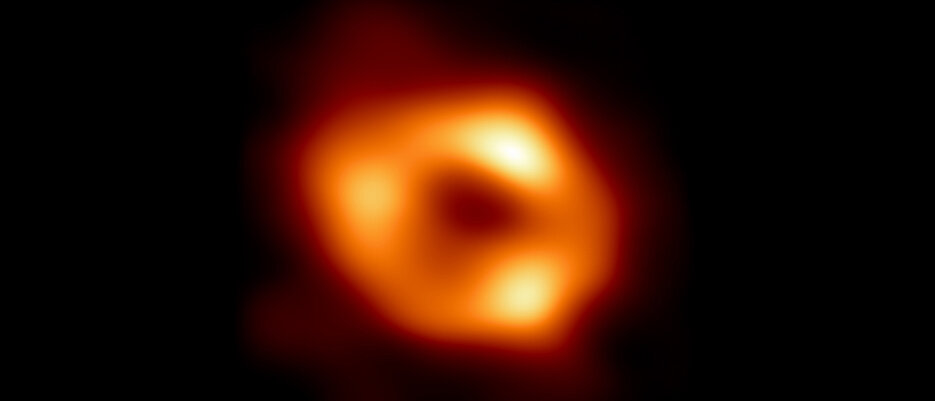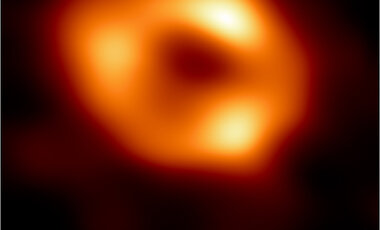First image of an Invisible
05/12/2022Astronomers have unveiled the first image of the supermassive black hole at the centre of our own Milky Way galaxy. Astronomers of the University of Würzburg were part of this collaboration.

This image was long awaited: It provides a glimpse of the massive object located at the centre of our galaxy - the Milky Way - and provides overwhelming evidence that the object is indeed a black hole. It also presents valuable clues about the workings of such giants, which are thought to be at the centre of most galaxies.
The first visual evidence
A global research team, the Event Horizon Telescope (EHT) Collaboration, is responsible for this, using observations from a worldwide network of radio telescopes. Previously, scientists had seen stars orbiting around an invisible, compact and very massive object in the centre of the Milky Way. This strongly suggested that this object - known as Sagittarius A* (Sgr A*, pronounced "sadge-ay-star") - is a black hole. The image now published provides the first direct visual evidence of this.
Black holes themselves are not visible because no light emanates from them. Nevertheless, the glowing gas surrounding them bears a telltale signature: a dark central region (called a “shadow”) surrounded by a bright ring-like structure. The new view captures light bent by the powerful gravity of the black hole, which is four million times more massive than our Sun.
A virtual telescope as big as the earth
“We were stunned by how well the size of the ring agreed with predictions from Einstein’s Theory of General Relativity," said EHT Project Scientist Geoffrey Bower from the Institute of Astronomy and Astrophysics, Academia Sinica, Taipei. "These unprecedented observations have greatly improved our understanding of what happens at the very centre of our galaxy, and offer new insights on how these giant black holes interact with their surroundings.” The EHT team's results are being published today in a special issue of The Astrophysical Journal Letters.
Because the black hole is about 27,000 light-years away from Earth, it appears to us to have about the same size in the sky as a donut on the Moon. To image it, the team created the powerful EHT, which linked together eight existing radio observatories across the planet to form a single “Earth-sized” virtual telescope. The EHT observed Sgr A* on multiple nights, collecting data for many hours in a row, similar to using a long exposure time on a camera.
The breakthrough follows the EHT collaboration’s 2019 release of the first image of a black hole, called M87*, at the centre of the more distant Messier 87 galaxy.
Striking similarity despite major differences
The two black holes look remarkably similar, even though our galaxy’s black hole is more than a thousand times smaller and less massive than M87* [Black holes are the only objects we know of where mass scales with size. A black hole a thousand times smaller than another is also a thousand times less massive.]. "We have two completely different types of galaxies and two very different black hole masses, but close to the edge of these black holes they look amazingly similar,” says Sera Markoff, Co-Chair of the EHT Science Council and a professor of theoretical astrophysics at the University of Amsterdam, the Netherlands. "This tells us that General Relativity governs these objects up close, and any differences we see further away must be due to differences in the material that surrounds the black holes.”
Like a puppy quickly chasing its tail
This achievement was considerably more difficult than for M87*, even though Sgr A* is much closer to us. EHT scientist Chi-kwan (‘CK’) Chan, from Steward Observatory and Department of Astronomy and the Data Science Institute of the University of Arizona, US, explains: “The gas in the vicinity of the black holes moves at the same speed — nearly as fast as light — around both Sgr A* and M87*. But where gas takes days to weeks to orbit the larger M87*, in the much smaller Sgr A* it completes an orbit in mere minutes. This means the brightness and pattern of the gas around Sgr A* was changing rapidly as the EHT Collaboration was observing it — a bit like trying to take a clear picture of a puppy quickly chasing its tail.”
The researchers had to develop sophisticated new tools that accounted for the gas movement around Sgr A*. While M87* was an easier, steadier target, with nearly all images looking the same, that was not the case for Sgr A*. The image of the Sgr A* black hole is an average of the different images the team extracted, finally revealing the giant lurking at the centre of our galaxy for the first time.
Hard work – even for supercomputers
The effort was made possible through the ingenuity of more than 300 researchers from 80 institutes around the world that together make up the EHT Collaboration. In addition to developing complex tools to overcome the challenges of imaging Sgr A*, the team worked rigorously for five years, using supercomputers to combine and analyse their data, all while compiling an unprecedented library of simulated black holes to compare with the observations. “The numerical simulations put even higher demands on the capabilities of supercomputers. They tell us about the dynamics of matter and the propagation of light in the curved space-time of the black hole shaping the observed image,” explains JMU researcher and EHT SgrA* Theory Working Group Coordinator Dr. Christian Fromm, who had leading contributions to the modelling of the EHT data. Fromm is also a member of the research group "Relativistic Jets in Active Galaxies", funded by the German Research Foundation, which started in 2021 at JMU.
Valuable insights into the evolution of galaxies
Scientists are particularly excited to finally have images of two black holes of very different sizes, which offers the opportunity to understand how they compare and contrast. They have also begun to use the new data to test theories and models of how gas behaves around supermassive black holes. This process is not yet fully understood but is thought to play a key role in shaping the formation and evolution of galaxies.
“Now we can study the differences between these two supermassive black holes to gain valuable new clues about how this important process works,” said EHT scientist Keiichi Asada from the Institute of Astronomy and Astrophysics, Academia Sinica, Taipei. “We have images for two black holes — one at the large end and one at the small end of supermassive black holes in the Universe — so we can go a lot further in testing how gravity behaves in these extreme environments than ever before.”
Focus in research and teaching at JMU
Progress on the EHT continues: a major observation campaign in March 2022 included more telescopes than ever before. The ongoing expansion of the EHT network and significant technological upgrades will allow scientists to share even more impressive images as well as movies of black holes in the near future.
“At the faculty of physics and astronomy at JMU Würzburg, we put a focus in research and teaching on the physics of relativistic jets of outflowing plasma in the immediate vicinity of supermassive black holes.” says JMU Professor Matthias Kadler and adds: “Even Bachelor and Master students at JMU are getting involved with new data from the EHT and other radio-interferometric arrays as part of their education and thesis projects.”
The telescopes involved
The individual telescopes involved in the EHT in April 2017, when the observations were conducted, were: the Atacama Large Millimeter/submillimeter Array (ALMA), the Atacama Pathfinder Experiment (APEX), the IRAM 30-meter Telescope, the James Clerk Maxwell Telescope (JCMT), the Large Millimeter Telescope Alfonso Serrano (LMT), the Submillimeter Array (SMA), the UArizona Submillimeter Telescope (SMT), the South Pole Telescope (SPT). Since then, the EHT has added the Greenland Telescope (GLT), the NOrthern Extended Millimeter Array (NOEMA) and the UArizona 12-meter Telescope on Kitt Peak to its network.
The EHT consortium
The EHT consortium consists of 13 stakeholder institutes; the Academia Sinica Institute of Astronomy and Astrophysics, the University of Arizona, the Center for Astrophysics | Harvard & Smithsonian, the University of Chicago, the East Asian Observatory, Goethe-Universitaet Frankfurt, Institut de Radioastronomie Millimétrique, Large Millimeter Telescope, Max Planck Institute for Radio Astronomy, MIT Haystack Observatory, National Astronomical Observatory of Japan, Perimeter Institute for Theoretical Physics, and Radboud University.
Links
Press release “New DFG Research Group”
The Astrophysical Journal Letters
Contacts
Dr. Christian Fromm, Chair of Astronomy, T: +49 931 31-81981, christian.fromm@physik.uni-wuerzburg.de
Prof. Dr. Matthias Kadler, Chair of Astronomy, T: +49 931 31-85138, matthias.kadler@astro.uni-wuerzburg.de
Additional images







